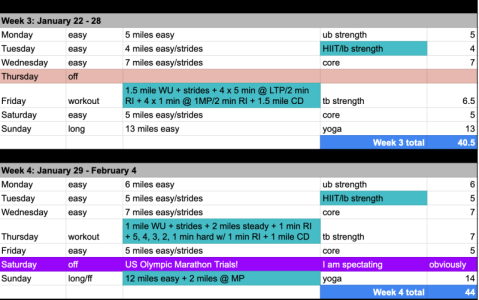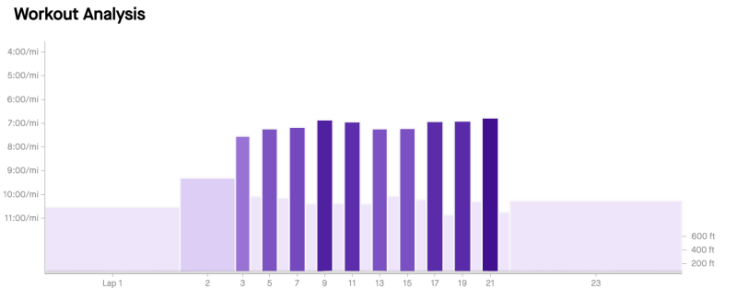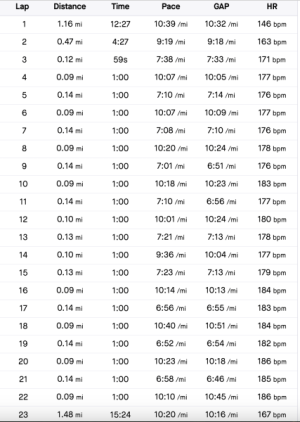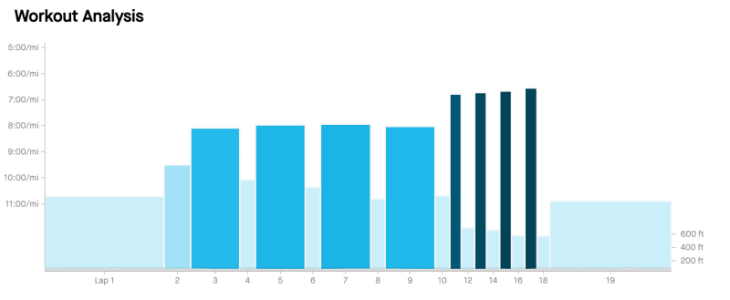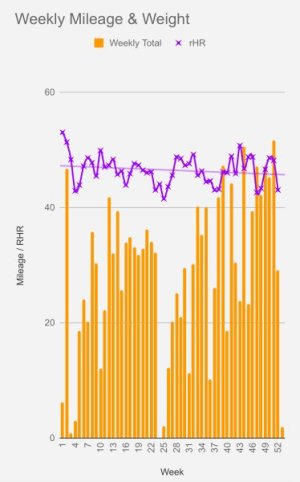Speed training 2024: first draft
In which I finally have a plan. Ish.
In my marathon plan, I more or less broke the full duration into shorter blocks focused on building up mileage, threshold pace, and marathon-specific work (plus the taper). That worked then because I was working pretty much exclusively towards the marathon. I did race a HM in week 6 (which I wouldn't do again but isn't
necessarily a terrible idea in theory), but it was not at all the point of my training.
This time, on the other hand, I have a couple of races on the schedule currently and will probably add a couple more. I have races in (
italics = tentative):
- Week 7 (Princess)
- Week 10 (RnR)
- Week 14 (parkrun)
- Week 17 (parkrun)
So I couldn't really do the same kind of segmentation of the plan.
I had to find a way to work the different systems I would need (mainly lactate threshold and faster) throughout the plan, but without stagnating.
I started by looking at the
Daniels 5K/10K plan, which Billy had recommended. I first noticed some lack of universality in the prescriptions (which we have already covered in depth

). But taking a step back, I saw that he's mainly hitting lactate threshold and R (sort of 1-mile race pace, sometimes), often in the same workout. Later in the plan he throws in the occasional H/I (3K pace) workout.
I was obviously not going to use the plan exactly as written for reasons we have already discussed, but I did adapt the structure of some of the workouts, particularly the LT + R combo. The other thing I took from his plan was the frequent strides. He has his runners doing strides after almost every easy run. Since I'm only doing one running workout per week, this seemed like a good way to get in a little extra speed practice, so I decided to try it. Just plain strides for now, but when I get back to DC, I'll try to do some of them on hills for extra oomph.
I also pulled the occasional idea from a bunch of other places:
Run Like a Pro by Matt Fitzgerald, some McMillan blog posts, even The Running Channel and the Tread Lightly podcast. Hopefully the variety of workouts throughout the plan will keep my fitness from plateauing!
I made a slight tweak to the
structure that I had initially planned, swapping Monday's core and Wednesday's upper body strength. I realized that would be more balanced. Plus I added more strides. So now I have in most weeks:
- Monday: easy + upper body strength
- Tuesday: easy/strides + lower body strength/HIIT
- Wednesday: easy (medium-long)/strides + upper body strength
- Thursday: off
- Friday: workout + total body strength
- Saturday: easy/strides + core
- Sunday: long + yoga
Weekly mileage is around the high 30s/low 40s, peaking close to 50, which is a good bit less than I did in M training. But lest you think that gives me some actual free time, lol, no: I think I'm going to be doing more strength and mobility work than I did in M training, so it'll probably be a similar time commitment. I'll then shift back to more mileage/less strength in the summer/fall.
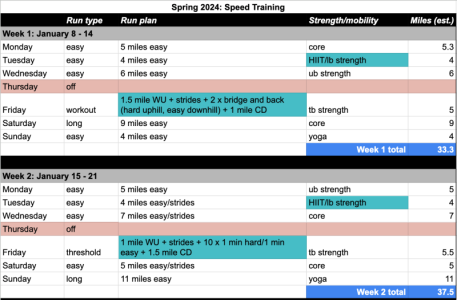 Weeks 1 and 2
Weeks 1 and 2 are kind of like pre-training: reminding my body how this all works again. One thing I have learned from the last few training cycles is that the first couple of weeks are consistently terrible, so I had my workouts based on effort rather than any specific paces. Also, I already did everything except tomorrow's long run, so no changes can be made

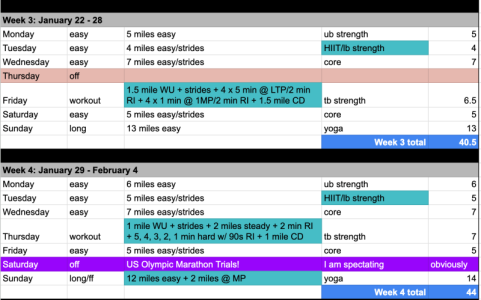
In
weeks 3 and 4, we start getting up in mileage a bit more and getting to some specified paces (which I will really, REALLY try not to overrun this time

). But recovery intervals are still a little longer than they would be later in the plan. I'm trying to keep things interesting with multiple paces and interval lengths in each workout, throwing in a fast-finish long run at the end of week 4.
Also I will be going to the Olympic trials! I'm excited. I tried to volunteer (honestly mostly because I wanted a t-shirt that says "US Olympic Marathon Trials"), but after I filled out like four surveys about availability and preferences, they waitlisted me, so I am currently planning on spectating. This is not related to my training at all except that I moved my rest day.
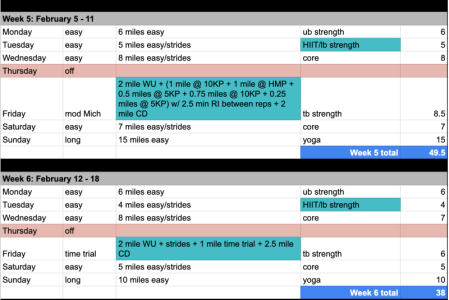
With two weeks remaining before Princess, I wanted to give myself at least a little bit of training at 10K pace in
week 5. But I also wanted to keep the variety, so I modified the Michigan - same general idea, just a little less volume. I thought about doing the whole thing, and I still might. We'll see how I feel in a few weeks.
The mile time trial in
week 6 is meant to give me a sense of where my fitness is leading up to the race. The long run takes a step back to keep my legs fresh going into Princess weekend.
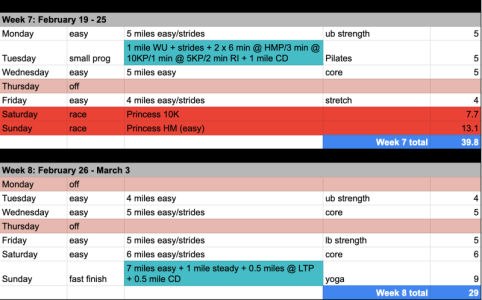 Week 7
Week 7 is race week! Just a little progression workout to keep myself from getting stale, and a shakeout run on Friday. This is definitely a very individual thing, but I find that my worst runs tend to be the day after a rest day, so I try to make sure I do a short run the day before any race. I'm probably racing the 10K and then taking it easy in the half on Sunday.
Then
week 8 is for recovery - and extra rest day and mostly easy, with just a little bit of a fast finish on Sunday.
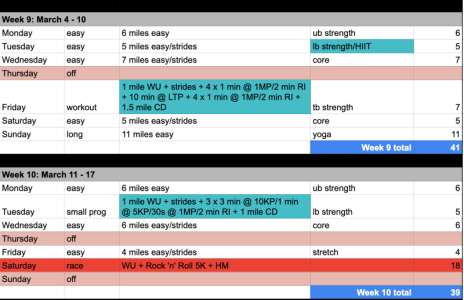
In
week 9, we're back to normal with an R/T/R sandwich. (I just use 1-mile pace instead of R because I find it easier.) I'm interested to see how this one goes.
Week 10 is another race week! (At least it is if I'm back home, which is still TBD.) Another small prog, this time with 5K pace in the middle since I'm racing a 5K, and the race on Saturday. You may have seen my 14/15-mile long runs and wondered why I would do such a thing for middle distance races - well, this is why. Between the warmup, 5K, and half on Saturday, I'll be at 18 miles or so for the day, and I don't want that to destroy me completely. Henceforth the long runs will be a little more reasonable

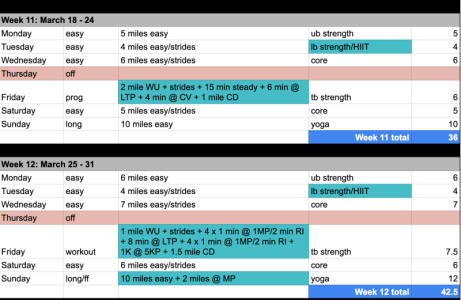
With the race(s) in week 10,
week 11 is a recovery week, with just a short progression for a workout. In
week 12, we're shortening the T but adding another layer to the R/T/R sandwich with 1 km at 5K pace at the end. Should be fun!

Wrapping things up with a fast-finish long run on Sunday.
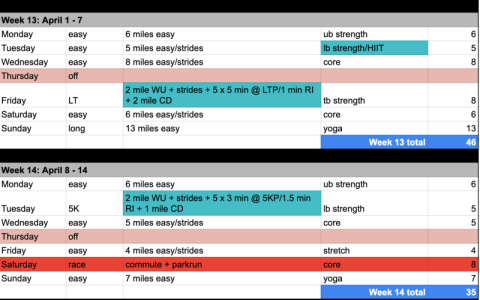
In
week 13, we're keeping things simple with some LT intervals and a solid long run. Then
week 14 is tentatively a "race" week - I'm planning to try a parkrun, which I've seen but never done before. For my race week workout, I thought I'd see if it makes a difference to do some light race-pace reps instead of a progression.
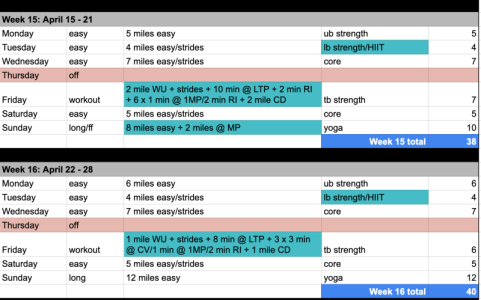 Week 15
Week 15 takes us back to that T + R combo with a fast-finish long run.
Week 16 is another twist on that workout, progressing from CV to R/1-mile pace before a rest.

Bonus week! I've actually got a
week 17 in this plan because of the spacing I was trying to get between races. Plus that means my last race is (tentatively) on Star Wars Day!

Seems appropriate. I haven't scheduled a specific workout for this race week yet because I want to see if it does make a difference exactly what I do, but it will probably be something similar to one of the previous race weeks.
(After Wednesday's discussion, I should probably add a disclaimer that this plan is only meant for me and my current fitness and goals! I am just sharing for those who are interested and/or have additional ideas and would not recommend anyone else use it

)
Sorry for the lack of dog photos - I had to use all of my images for training plan screenshots

But anyway, here's your time to shine, friends!
Questions? Thoughts? Concerns? Suggestions? Anything look weird? Workouts too repetitive? Any ideas or insights are welcome!











 Seems appropriate. I haven't scheduled a specific workout for this race week yet because I want to see if it does make a difference exactly what I do, but it will probably be something similar to one of the previous race weeks.
Seems appropriate. I haven't scheduled a specific workout for this race week yet because I want to see if it does make a difference exactly what I do, but it will probably be something similar to one of the previous race weeks.